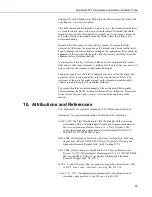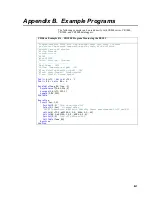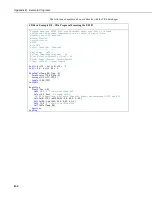
C-1
Appendix C. Absolute Humidity
The EE181 measures relative humidity. Relative humidity is defined by the
equation below:
100
e
e
RH
s
•
=
(C-1)
where RH is relative humidity, e is vapor pressure in kPa , and e
s
is saturation
vapor pressure in kPa. Vapor pressure, e, is an absolute measure of the amount
of water vapor in the air and is related to the dewpoint temperature. Saturation
vapor pressure is the maximum amount of water vapor that air can hold at a
given air temperature. The relationship between dewpoint and vapor pressure,
and air temperature and saturation vapor pressure are given by Goff and Gratch
(1946), Lowe (1977), and Weiss (1977). Relative humidity is relative to
saturation above water, even below freezing point. This is why these sensors
should not measure 100% RH below zero degrees C, as described in Appendix
(p. C-3)
When the air temperature increases, so does the saturation vapor pressure.
Conversely, a decrease in air temperature causes a corresponding decrease in
saturation vapor pressure. It follows then from Eq. (C-1) that a change in air
temperature will change the relative humidity, without causing a change
absolute humidity.
For example, for an air temperature of 20 °C and a vapor pressure of 1.17 kPa,
the saturation vapor pressure is 2.34 kPa and the relative humidity is 50%. If
the air temperature is increased by 5 °C and no moisture is added or removed
from the air, the saturation vapor pressure increases to 3.17 kPa and the relative
humidity decreases to 36.9%. After the increase in air temperature, there is
more energy to vaporize the water. However, the actual amount of water vapor
in the air has not changed. Thus, the amount of water vapor in the air, relative
to saturation, has decreased.
Because of the inverse relationship between relative humidity and air
temperature, finding the mean relative humidity is often not useful. A more
useful quantity is the mean vapor pressure. The mean vapor pressure can be
computed by the datalogger program as shown in the following examples.
CRBasic Example C-1. CR1000 Program that Computes Vapor Pressure and Saturation
Vapor Pressure
'Program measures EE181 with single-ended inputs once every 5 seconds
'and stores the average temperature and a sample of the relative
'humidity every 60 minutes.
'Wiring Diagram
'==============
'EE181
'Wire CR1000
'Color: Function - Terminal
'------ -------- --------
'Red: Power - SW12
'Yellow: Temperature signal - SE1
'Blue: Relative Humidity signal - SE2
'Black: Power Ground - Ground Symbol
Summary of Contents for EE181
Page 2: ......
Page 6: ......
Page 24: ......
Page 30: ...Appendix C Absolute Humidity C 4...
Page 31: ......




















